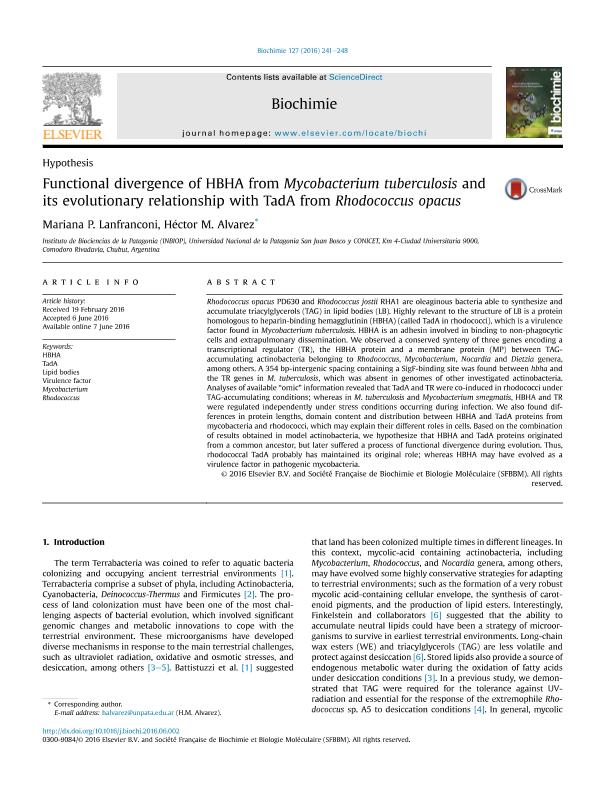Mostrar el registro sencillo del ítem
dc.contributor.author
Lanfranconi, Mariana Patricia

dc.contributor.author
Alvarez, Hector Manuel

dc.date.available
2018-01-31T19:14:05Z
dc.date.issued
2016-06-07
dc.identifier.citation
Lanfranconi, Mariana Patricia; Alvarez, Hector Manuel; Functional divergence of HBHA from Mycobacterium tuberculosis and its evolutionary relationship with TadA from Rhodococcus opacus; Elsevier Masson; Biochimie; 127; 7-6-2016; 241-248
dc.identifier.issn
0300-9084
dc.identifier.uri
http://hdl.handle.net/11336/35237
dc.description.abstract
Rhodococcus opacus PD630 and Rhodococcus jostii RHA1 are oleaginous bacteria able to synthesize and accumulate triacylglycerols (TAG) in lipid bodies (LB). Highly relevant to the structure of LB is a protein homologous to heparin-binding hemagglutinin (HBHA) (called TadA in rhodococci), which is a virulence factor found in Mycobacterium tuberculosis. HBHA is an adhesin involved in binding to non-phagocytic cells and extrapulmonary dissemination. We observed a conserved synteny of three genes encoding a transcriptional regulator (TR), the HBHA protein and a membrane protein (MP) between TAG-accumulating actinobacteria belonging to Rhodococcus, Mycobacterium, Nocardia and Dietzia genera, among others. A 354 bp-intergenic spacing containing a SigF-binding site was found between hbha and the TR genes in M. tuberculosis, which was absent in genomes of other investigated actinobacteria. Analyses of available “omic” information revealed that TadA and TR were co-induced in rhodococci under TAG-accumulating conditions; whereas in M. tuberculosis and Mycobacterium smegmatis, HBHA and TR were regulated independently under stress conditions occurring during infection. We also found differences in protein lengths, domain content and distribution between HBHA and TadA proteins from mycobacteria and rhodococci, which may explain their different roles in cells. Based on the combination of results obtained in model actinobacteria, we hypothesize that HBHA and TadA proteins originated from a common ancestor, but later suffered a process of functional divergence during evolution. Thus, rhodococcal TadA probably has maintained its original role; whereas HBHA may have evolved as a virulence factor in pathogenic mycobacteria.
dc.format
application/pdf
dc.language.iso
eng
dc.publisher
Elsevier Masson

dc.rights
info:eu-repo/semantics/openAccess
dc.rights.uri
https://creativecommons.org/licenses/by-nc-sa/2.5/ar/
dc.subject
Hbha
dc.subject
Tada
dc.subject
Lipid Bodies
dc.subject
Mycobacterium
dc.subject
Virulence Factor
dc.subject
Rhodococcus
dc.subject.classification
Otras Ciencias Biológicas

dc.subject.classification
Ciencias Biológicas

dc.subject.classification
CIENCIAS NATURALES Y EXACTAS

dc.title
Functional divergence of HBHA from Mycobacterium tuberculosis and its evolutionary relationship with TadA from Rhodococcus opacus
dc.type
info:eu-repo/semantics/article
dc.type
info:ar-repo/semantics/artículo
dc.type
info:eu-repo/semantics/publishedVersion
dc.date.updated
2017-12-12T20:02:42Z
dc.journal.volume
127
dc.journal.pagination
241-248
dc.journal.pais
Francia

dc.journal.ciudad
Paris
dc.description.fil
Fil: Lanfranconi, Mariana Patricia. Universidad Nacional de la Patagonia ; Argentina. Consejo Nacional de Investigaciones Científicas y Técnicas; Argentina
dc.description.fil
Fil: Alvarez, Hector Manuel. Universidad Nacional de la Patagonia ; Argentina. Consejo Nacional de Investigaciones Científicas y Técnicas; Argentina
dc.journal.title
Biochimie

dc.relation.alternativeid
info:eu-repo/semantics/altIdentifier/doi/http://dx.doi.org/10.1016/j.biochi.2016.06.002
dc.relation.alternativeid
info:eu-repo/semantics/altIdentifier/url/www.elsevier.com/locate/bioch
Archivos asociados
